Diplomatic Bluebook 2017
Chapter 3
Japan's Foreign Policy to Promote National and Worldwide Interests
1.Development Cooperation (ODA, etc.)
(1) The Current Status of ODA
A FY2016 Priority Policy for Development Cooperation
From the perspective of “Proactive Contribution to Peace” based on the principle of international cooperation, development cooperation is one of the most important tools toward further contributing to securing the peace, stability, and prosperity of the international community, and promoting Japan's diplomatic policies. With the aim of promoting strategic and effective development cooperation based on the Development Cooperation Charter, the Ministry of Foreign Affairs has positioned the following as priority issues for FY2016 and will tackle these challenges while strengthening cooperation with various entities.
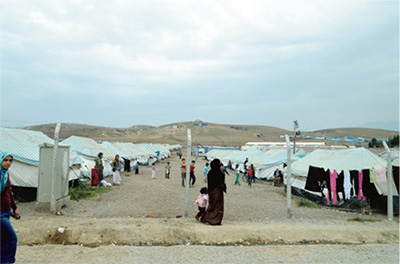 Syrian refugee camp located in the southeast part of Turkey, where most of the refugees are concentrated. Japan provides support mainly to local governments in Turkey with the aim of reducing the burden on the host country in areas such as water and sewage, and waste disposal. (Photo: JICA)
Syrian refugee camp located in the southeast part of Turkey, where most of the refugees are concentrated. Japan provides support mainly to local governments in Turkey with the aim of reducing the burden on the host country in areas such as water and sewage, and waste disposal. (Photo: JICA)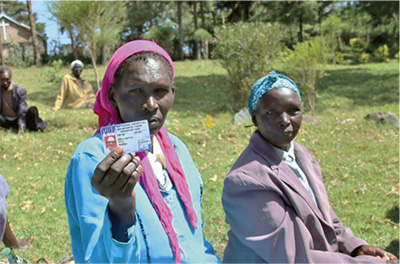 Users of the Health Insurance Subsidy Program (HISP) for the poor, which is one of the key actions supported by the Health Sector Policy Loan for Attainment of the Universal Health Coverage that Japan offers to Kenya. (Photo: JICA)
Users of the Health Insurance Subsidy Program (HISP) for the poor, which is one of the key actions supported by the Health Sector Policy Loan for Attainment of the Universal Health Coverage that Japan offers to Kenya. (Photo: JICA)(A) Improving the environment and sharing universal values to achieve international peace and stability
Through cooperation on humanitarian assistance, counter-terrorism, peacebuilding, and strengthening maritime law enforcement capabilities, Japan contributes proactively to the realization of peace and stability for the international community. Japan is involved in cooperative initiatives including the development of legal systems and strengthening of governance in order to support efforts by countries sharing universal values such as democracy, the rule of law, and human rights, and to strengthen the relationship of these countries with Japan. Through development cooperation, Japan also puts effort into fostering pro-Japanese groups and Japanologists, strengthening networks, and the active communication of Japan's appeal and initiatives to other countries.
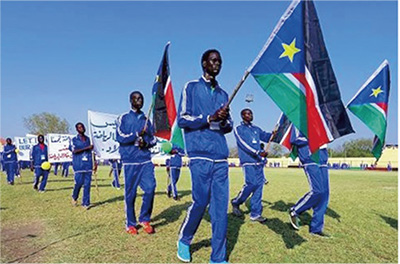 National Sports Event (South Sudan)
National Sports Event (South Sudan)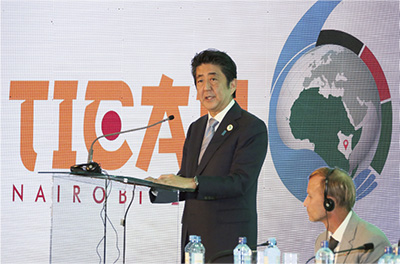 This event was held for the first time after the country gained independence in 2011 with support from Japan. Athletes from different regions, of different ethnic groups, competed against one another in the spirit of fair play. (Photo: JICA)
This event was held for the first time after the country gained independence in 2011 with support from Japan. Athletes from different regions, of different ethnic groups, competed against one another in the spirit of fair play. (Photo: JICA)(B) Addressing global challenges and promoting human security through implementation of the 2030 Agenda for Sustainable Development
Japan has been accelerating the implementation of the 2030 Agenda for Sustainable Development based on the philosophy of human security. Japan will make efforts to address global issues through promoting cooperation in various areas such as health, education, disaster risk reduction, gender, and environment and climate change.
(C) Contributing to economic diplomacy and regional revitalization with the aim of achieving “quality growth” alongside developing countries
In order to contribute to economic growth and regional revitalization in Japan, and at the same time, engage in cooperation toward the realization of “quality growth” in developing countries, Japan is involved in cooperative efforts that contribute to the export of infrastructure systems. In cooperation with economic diplomacy initiatives including the TPP agreement, it also works to improve the environment for foreign direct investment, and to support the overseas expansion of local governments and small and medium-sized enterprises. Furthermore, Japan provides support for the development of human resources for industries in developing countries and engages in cooperation on the international expansion of medical technologies and services through the promotion of Japanese standards.
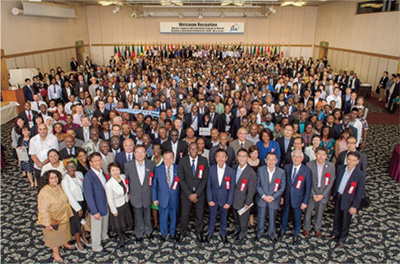 Prime Minister Abe delivering a speech at the High-Level Panel on UHC in Africa, held during TICAD VI. (Photo: Cabinet Public Relations Office)
Prime Minister Abe delivering a speech at the High-Level Panel on UHC in Africa, held during TICAD VI. (Photo: Cabinet Public Relations Office)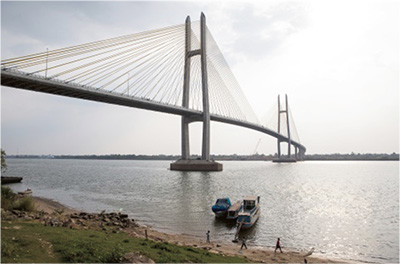 International students who had come to Japan through the African Business Education Initiative for Youth (ABE Initiative), targeted at youths in Africa. These students are expected to play an active role in leading the business sector in Africa. (Photo: JICA)
International students who had come to Japan through the African Business Education Initiative for Youth (ABE Initiative), targeted at youths in Africa. These students are expected to play an active role in leading the business sector in Africa. (Photo: JICA)(D) Strengthening cooperation with various entities
In tackling the above-mentioned priority areas, (A) to (C), Japan seeks to strengthen cooperation with various entities. Based on the Development Cooperation Charter, Japan strives to establish the implementation systems necessary for the strategic expansion of its development cooperation, and at the same time, further strengthen cooperation with private companies, local governments, universities and research institutions, NGOs and CSOs, and international/regional organizations.
B Safety Measures for Personnel Engaged in International Cooperation Projects
In the terrorist attacks that struck Dhaka, the capital of Bangladesh, in July, seven Japanese engaged in ODA efforts lost their lives while one Japanese was injured. The government is determined to continue supporting developing countries, and to never give in to terrorism; however, the international terrorism situation is becoming increasingly severe. To ensure the safety of Japanese personnel engaged in international cooperation abroad, it is vital to establish a new system for ensuring utmost preparedness.
From the standpoint of such awareness, the Council on Safety Measures for International Cooperation Projects was established under the Minister for Foreign Affairs. After five meetings with participation from many members from the relevant ministries and agencies, the Council published its final report at the end of August which sets forth new safety measures for personnel engaged in international cooperation projects. The final report covered the safety measures that should be taken in cooperation between the MOFA and the JICA, with the relevant parties, in accordance with the following five pillars: (1) Strengthening the collection, analysis, and sharing of threat information; (2) Code of conduct of partners and NGOs; (3) Physical/non-physical protective measures, and strengthening training and drills; (4) Post-crisis response; and (5) Heightening crisis management awareness and improving the organizational structure of the MOFA and the JICA.
Going forward, Japan will keep up the steady implementation of new safety measures in order to continue contributing proactively to the peace, stability, and prosperity in the international community as a responsible major power, and at the same time, ensure the safety of personnel engaged in international cooperation projects.
(2) Japan's Development Cooperation Performance and Approaches to Major Regions
A Japan's ODA Performance
In 2015, Japan provided approximately 15.03 billion US dollars in ODA3, 5.6% less than the previous year on the basis of total disbursements. Japan ranks fourth among the member states of the Organization for the Economic Co-operation and Development/ Development Assistance Committee (OECD/DAC), following the U.S., Germany, and the UK. In terms of net disbursements generally used for international comparison, the amount is about 9.2 billion US dollars, down 3.0% from the previous year, ranking fourth after the U.S., the UK, and Germany. The ODA/GNI ratio based on net disbursements was 0.21%, ranking 19th among member states of the DAC.
- 3 The main forms of ODA from Japan are: grant aid, namely, bilateral fund donations; loan aid for development in developing regions; technical cooperation; donations or contributions to international organizations. Of these, loan aid for development accounts for the largest percentage. Loan aid for development is typically repaid with interest.
B Approaches to Major Regions
(A) Southeast and Southwest Asia
The peace, stability, and prosperity in the Southeast Asian region are important to Japan, which has a close relationship with the region. Japan has created momentum toward solutions for various development issues including poverty reduction, by promoting economic development and human security in the region through development cooperation, and also contributed to the development of the region.
Approximately 52.8% of the total bilateral ODA of Japan went to this region in 2015. A large portion of it is support for ASEAN countries. Considering that support for infrastructure building and training of industrial human resources to strengthen regional connectivity and industrial foundation development are essential to sustainable growth in the region, Japan is implementing quality infrastructure development in various countries in the region, as well as providing steady support for the development of human resources for industries in the region based on the Industrial Human Resource Development Cooperation Initiative, which aims to develop 40,000 industrial human resources in the next three years. In light of the fact that the countries of ASEAN are located along Japan's sea lanes, and that the region is an important one for regional security, Japan is steadily providing support in the area of maritime safety through ODA, including the provision of patrol boats and the related equipment, and human resource development. In addition to these efforts, Japan is also providing support to eradicate domestic disparity as well as in the region, and for the creation of a sustainable society in areas including disaster risk reduction, environment and climate change, and energy. At the same time, Japan has announced at the Japan-ASEAN Summit Meeting held in September 2016 that it will be contributing 45 billion yen in support and developing human resources of 2,000 people over the next three years toward the realization of Asia that is resilient against terrorism. Japan is also working proactively to tackle new challenges.
In the Mekong region, in accordance with the New Tokyo Strategy 2015 for Mekong-Japan Cooperation adopted at the Mekong-Japan Summit Meeting in July 2015, Japan announced that it will be providing steady support through 750 billion yen in ODA funding over the next three years. Under the new Japan-Mekong Connectivity Initiative launched at the Mekong-Japan Foreign Minister's Meeting held in July 2016, Japan will also support the realization of “vibrant and effective connectivity” through further infrastructure development, systemic improvements, and development of the surrounding areas in the region.
By providing such assistance, Japan aims to provide strong support to the ASEAN Community established in December 2015.
The economy has developed in Southwest Asia, but many issues such as undeveloped infrastructure and poverty still remain unsolved. While also keeping in mind improving the investment environment for Japanese companies and human security, Japan provides a range of assistance through ODA to assist the region in overcoming these challenges.
With regard to Sri Lanka, Prime Minister Abe declared at the Japan-Sri Lanka Summit Meeting held in May that Japan will strengthen its cooperative relationship with Sri Lanka under the “Expanded Partnership for Quality Infrastructure” and develop the Port of Colombo and its surrounding areas through joint public-private efforts.
With regard to India, at the Summit Meeting held in November, the steady progress of the Mumbai-Ahmedabad High-Speed Railway Project was noted. Prime Minister Modi also expressed his gratitude to Japan for the important contributions that Japan's ODA has made toward the development and modernization of infrastructure in India.

(B) Central Asia
The Central Asia and the Caucasus are geopolitically important areas surrounded by Russia, China, South Asia, the Middle East, and Europe. Its stability and development are important for all in the whole Eurasia, including Japan. Japan supports the “open, stable, and independent” development of Central Asia, and upholds the ideal of Japanese diplomacy that contributes to peace and stability in the region and around the world. Japan supports nation building that allows universal values such as human rights, democracy, market economy, and the rule of law to take root for long-term stability and sustainable development in this region with broad-based views covering neighboring regions including Afghanistan and Pakistan in mind.
In 2016, as a follow-up to Prime Minister Abe's visit to Central Asia in the previous year, Japan engaged in cooperation in areas such as infrastructure development, health and medical care, border control, and anti-narcotics measures. It also strengthened cooperation in the area of human resource development, including support for highly skilled industrial human resource development by using Japanese style engineering education such as colleges of technology, expansion of the program for young government officials' study in Japan as well as the launch of new cooperative projects for Japan Centers. In-depth discussions were also held about cooperation in the areas of transportation and logistics, a new topic on cooperation in the “Central Asia+Japan” Dialogue.
(C) Central and South America
Central and South America has enjoyed friendly relations with Japan for a long time and have deep historical ties with Japan, as demonstrated by the fact that about 2.13 million Japanese descendants, Nikkei, reside in the region. The region is a major supplier of resources and food, as well as a potential new market with gross regional production amounting to approximately 5 trillion US dollars. On the other hand, many countries in the region are confronted by problems such as domestic income disparity and poverty in the agricultural and mountainous regions. Central and South America is also highly vulnerable to natural disasters and it is becoming increasingly challenging to tackle problems in the areas of environment/climate change and disaster risk reduction. Japan is engaged in various cooperative efforts while also taking into account the characteristics of each country in the Central and South America region.
In April, President Varela of Panama visited Japan, and the two governments signed an Exchange of Note concerning the “Panama Metropolitan Area Urban Transportation Line-3 Development Project” with the aim of contributing to sustainable economic growth in Panama. In September, Prime Minister Abe became the first Prime Minister of Japan to visit Cuba, where he stated Japan will promote economic cooperation in a substantive manner through the provision of grant aid, etc., and establish a local office of the JICA as well as other initiatives. In November, Prime Minister Abe visited Peru and Argentina. He announced continued support in the areas of environment and disaster risk reduction for Peru, and assistance for small and medium-sized enterprises for Argentina.
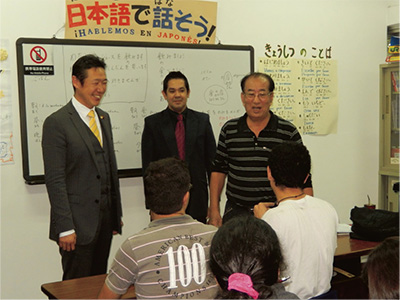 Parliamentary Vice-Minister for Foreign Affairs Kikawada visiting the Centro Paraguayo Japonesa, built and maintained through grant aid from Japan (May 6, Paraguay).
Parliamentary Vice-Minister for Foreign Affairs Kikawada visiting the Centro Paraguayo Japonesa, built and maintained through grant aid from Japan (May 6, Paraguay).(D) The Middle East
Securing peace and stability in the Middle East and North Africa regions, which are geopolitically important and important for energy security, is crucial not only for the stability of Japan but also of the world. From these standpoints, Japan has proactively provided support for these regions to achieve peace and stability.
Taking the opportunity at the G7 Ise-Shima Summit held in May, Japan announced that it will provide support amounting to approximately 6 billion US dollars over the next three years, including support for human resource development for about 20,000 people. The objective is to build a “tolerant and stable society” in the Middle East while stemming the growth of violent extremism based on the stance that “the best way is to go is in the middle.” From the perspective of developing human resources capable of taking leadership roles in the reconstruction of Syria in the future, Japan announced that it will accept up to 150 Syrian students over the next five years.
At the United Nations Security Council High-level Briefing held during the UN General Assembly in September, Japan announced its intention to provide support amounting to about 1.13 billion US dollars during 2016 to assist refugees and displaced persons in Syria, Iraq, and the surrounding countries. Furthermore, at the “United Nations Summit for Refugees and Migrants” and the “Leaders' Summit on Refugees” hosted by President Obama of the U.S., Japan announced that approximately 2.8 billion US dollars in total will be provided for humanitarian and self-reliance assistance to refugees and migrants and to host countries and communities during the three years from 2016, as well as support amounting to approximately 100 million US dollars to the World Bank's Global Crisis Response Platform.
Furthermore, Japan and the international community are providing support in nation-building, toward the stability and self-reliance of Afghanistan in order to prevent it from stepping back into a hotbed of terrorism. At the Brussels Conference on Afghanistan, participating countries and organizations pledged support of a total of 15.2 billion US dollars. Japan announced its intention to continue its assistance worth up to 40 billion yen per year for four years from 2017 to 2020, based on the principle of mutual accountability whereby the ability of the Afghanistan government to produce results on its commitment toward reform hinges on the continued support of the international community.
(E) Africa
Africa has achieved a significant economic growth thanks to abundant natural resources and a rapidly growing population. As a potential market, it is attracting the attention and anticipation of the international community. Since 1993, Japan has worked with African countries as well as supporting countries and organizations to tackle Africa's development issues through the processes of the Tokyo International Conference on African Development (TICAD), and continued to provide support toward the realization of economic growth in Africa. TICAD processes further strengthen relations between Japan and Africa and serve as a forum for discussing the further development of Africa while respecting the ownership of the African countries. For these reasons, the TICAD framework has been highly appraised by the countries of Africa. Initially held once every five years, it became an event held once every three years after the 5th session in 2013. TICAD VI was held in August 2016 and was the first TICAD meeting to be convened in Africa, in Nairobi, Kenya (see Special Feature “TICAD VI ~ The Private Sector's Interest in Africa”).
TICAD VI welcomed the participation of delegates from 53 countries in Africa, including ministerial-level delegates as well as delegates from development partner countries, countries in Asia, international organizations, regional organizations, the private sector, and NGO representatives. Active discussions were held on: (1) Economic diversification and industrialization; (2) Promoting resilient health systems; and (3) Promoting social stability. As a result, the Nairobi Declaration was adopted with these three priority areas as the pillars of the declaration. Prime Minister Abe, who co-chaired the summit, said in his keynote speech that in the three years between 2016 and 2018, Japan will invest in the future of Africa with 30 billion US dollars from the public and private sectors combined. In line with the three priority areas outlined in the Nairobi Declaration, this investment will be injected into initiatives such as the human resource development for approximately 10 million people by harnessing Japan's strength of possessing “high-quality”, developing quality infrastructure and promoting resilient health systems as well building the foundations for peace and stability.
The next TICAD, which will be TICAD VII, is scheduled to be held in Japan in 2019. Going forward, Japan will harness its strengths to provide steady support in areas such as economic growth that incorporates private-sector investment, development, and the promotion of social stability. At the same time, Japan will build mutually beneficial relationships with the countries of Africa and will continue to contribute to the realization of Africa's “quality growth” through cooperation between the public and private sectors.
(3) Approaches to Appropriate and Effective Implementation of ODA
A Approaches to Appropriate Implementation of ODA
In the implementation of ODA, efforts are made to enhance transparency by exchanging external experts at each phase and formulating projects based on these discussions. In the phase of preliminary studies in the implementation of ODA, the Development Project Accountability Committee has held open sessions and decides whether studies should be implemented based on reviews and discussions conducted with external experts. Furthermore, after the implementation of the project, the JICA publishes on its website the ex-post evaluation results for all projects valued at 200 million yen or more, while ex-post evaluations are also conducted by third parties for projects valued at 1 billion yen or more. The matters pointed out in such ex-post evaluations are applied to the formulation of future ODA projects.
B Approaches to Effective Implementation of ODA
ODA is implemented through three frameworks corresponding to the needs of the partner country and the scale of the project: grant aid, loan aid, and technical cooperation. In order to utilize the limited budget efficiently and achieve a high level of development, the MOFA and the JICA take into account the needs of the partner country, establish priority areas of cooperation for each country, and formulate projects that contribute to these areas while going beyond the boundaries of each framework. For example, in the land-locked country of Rwanda, the high costs of transportation when passing through the land to enter the ocean poses a significant challenge. For that reason, Japan has offered grant aid to construct new bridges and facilities (One-Stop Border Post: OSBP) to facilitate border procedures at the border between Rwanda and Tanzania and has provided support to improve the operational capability of the OSBP facility through technical cooperation. To further promote such initiatives, Japan decided in July to provide support, through loan aid, for repairing and extending the roads that connect Rwanda to the Tanzania border.
Japan also contributes to the creation of international frameworks for effective ODA implementation. The Global Partnership for Effective Development Cooperation (GPEDC) exists as a framework that various development entities participate in with the aim of enabling the international community to work as one toward improving the effectiveness of development cooperation for developing countries. These entities are not limited to developed and developing countries, but also include civil society, the private sector and so on. Japan has been serving on the Steering Committee of the GPEDC since September 2015. At the 2nd High-level Meeting of the GPEDC in November 2016, Japan introduced its initiatives in the areas that are its strengths, such as triangular cooperation, and these initiatives were highly appraised by other participants.
C Efforts toward Promotion of Information Disclosure and Improvement Development of Cooperation Quality
The understanding and support from Japanese citizens is essential for the implementation of development cooperation. Therefore, efforts are made for effective communication and higher quality of development cooperation to enhance their understanding of ODA. Various PR events took place aiming to reach out to a wide range of people. Specifically, participatory type events such as “Global Festa Japan 2016,” Japan's largest event for international cooperation, in Odaiba, Tokyo, in October, and “One World Festival” in Osaka City in February were held. In addition to these, a TV publicity program (If I Change, the Future will Change: Search for the Treasures of Japan that Have Travelled Across the Seas!) was broadcasted to present some examples of international cooperation activities conducted by Japan all over the world, and to explain the meaning of development cooperation for Japan in an easy-to-understand manner, based on the reports from ODA sites in developing countries. Also, efforts are continuously made to deliver information on development cooperation through the ODA website. Furthermore, based on the Development Cooperation Charter, which declares enhanced efforts for overseas publicity, Japan plans tours to its development cooperation project sites for the local media so that they will cover Japan's cooperation, and prepares PR pamphlets in English and local languages.
In order to raise the quality of ODA, it is necessary to apply knowledge and know-how gained from ODA evaluations to subsequent policy planning and project implementation. MOFA carries out evaluations by external experts at a policy and program level, and the results are shared and used by relevant parties. Also, from the viewpoint of improving transparency of the JICA's projects, the JICA publicizes their current status and achievements on the “Visible ODA” section of its website. As of the end of December 2016, a total of 3,724 projects are listed on this site.
